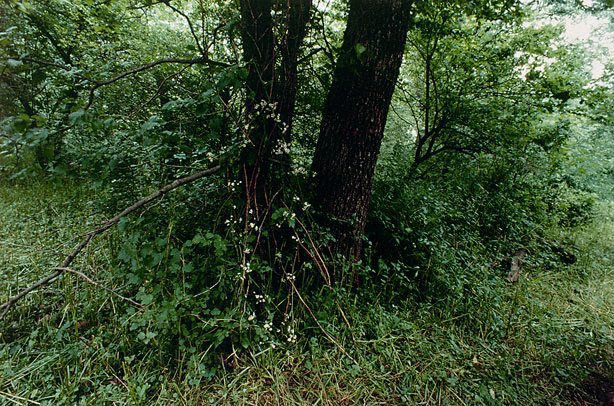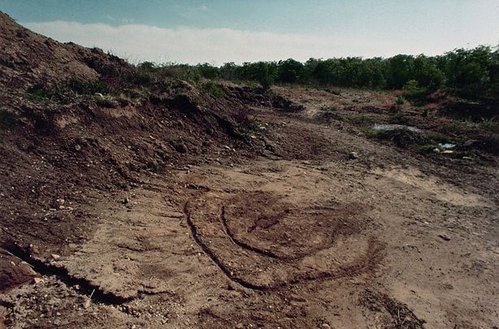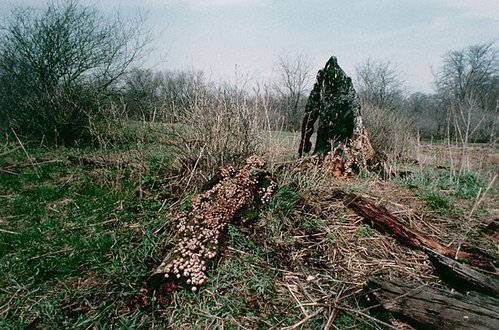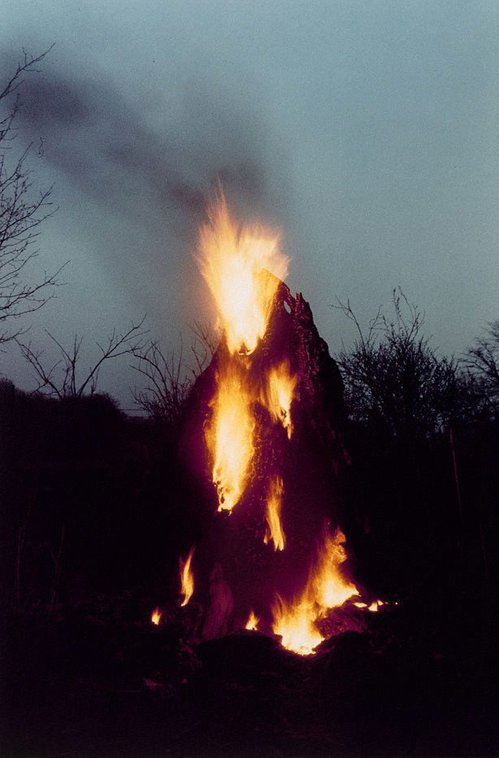Title
Colour photograph documenting earth / body work with tree and flowers, Iowa, from the series Silueta works in Iowa and Oaxaca Mexico
1976-1978
printed 1991
Artist
-
Details
- Dates
- 1976-1978
printed 1991 - Media category
- Photograph
- Materials used
- type C photograph
- Edition
- 5/20
- Dimensions
- 33.6 x 50.7 cm image; 40.6 x 50.7 cm sheet
- Signature & date
Not signed. Not dated.
- Credit
- Purchased with funds provided by the Mervyn Horton Bequest 1997
- Location
- Not on display
- Accession number
- 349.1997.3
- Copyright
- © Courtesy of the Estate of Ana Mendieta and Galerie Lelong, New York
- Artist information
-
Ana Mendieta
Works in the collection
- Share
-
-
About
Ana Mendieta was born in Cuba but moved without her parents to Iowa at the age of 13. Her professional parents feared for the future of intellectuals in Cuba and took advantage of Operation Pedro Pan, a Catholic-sponsored program that sent 20,000 Cuban children to foster homes in the 1960s. Coming at such an influential age, this separation and exile coloured the work she was to make in her short lifetime. She also carried with her fond memories of illicit sessions with her nannies, who talked to her and her sister about the Afro Cuban cult of Santeria (the sessions were held secretly as Ana’s parents disapproved of this superstitious combination of Catholicism and Voodoo). This childhood memory partly explains the expressive language that runs parallel with her more systematic university-acquired attitude to performance art. Sometimes there is an uncomfortable tension between her feminist practice and her determination to recapture this magical power that connects the human spirit to the earth.
‘This sense of magic, knowledge and power found in primitive art has influenced my personal attitude toward art making. For the past twelve years I have been working out in nature exploring the relation-ship between myself, the earth and art.’1
At Iowa College, where she studied art, Mendieta was exposed to feminist and performance artists, and became very much aware of the feminist debates that animated intellectual life at that time. Her earliest performance art was shaped by the most rigorous and literal instructional actions and yet they were imbued with powerful ancestral traces. For example ‘Sweating blood’ 1972 involved simply opening a wound in her scalp and allowing blood to slowly trickle down her face. ‘Body tracks’ 1973 enacted a simple bodily gesture of spreading her body against a wall and slowly slumping to the floor, leaving a trail of blood where her arms formed two arcs to the floor.
Iowa and Oaxaca in Mexico are the sites of her ‘Silueta’ series, in which she made templates from her body and used these to create impressions in the landscape. Sometimes these took on a ritual cast, as for example when she used fire or flowers to mark out her absent form. As a feminist, these works could be seen as enacting the effacement of women from the cultural construction of the land or as an over identification with it, as for example with the figure of an earth goddess. Mendieta herself may have been ambivalent about this. In his essay on Mendieta for the 1997 exhibition ‘Body’, Charles Merewether quotes her in one telling passage: ‘The risk was of dissolution, a yielding or trend to lose oneself in the environment instead of playing an active role in it; the tendency to let oneself go and sink back into nature.’2
1. Text from Mendieta’s grant application State Council on the Arts, 17 March 1982, quoted in ‘Art in America’ article by Michael Duncan, vol 87, no 9, April 1999, p 154.
2. Mendieta quoted by Charles Merewether in ‘The unspeakable condition of figuration’ in ‘Body’, AGNSW, Sydney 1997, pp 155–56.© Art Gallery of New South Wales Contemporary Collection Handbook, 2006
-
Exhibition history
Shown in 4 exhibitions
Body, Art Gallery of New South Wales, Sydney, 12 Sep 1997–16 Nov 1997
Ideas and Actions: Performance, Process and Documentation, Art Gallery of New South Wales, Sydney, 29 Oct 1999–23 Jan 2000
Connecting t the Earth: Ana Mendieta, Institute of Modern Art, Fortitude Valley, 02 Feb 2019–30 Mar 2019
20th-Century galleries, lower level 1 (rehang), Art Gallery of New South Wales, Sydney, 20 Aug 2022–2023
-
Bibliography
Referenced in 2 publications
-
Anthony Bond, Contemporary: Art Gallery of New South Wales Contemporary Collection, 'Imagining the body', pg.246-289, Sydney, 2006, 280, 281 (colour illus.).
-
Anthony Bond, Body, 'Embodying the Real', pg. 11-80, Sydney, 1997, 28, 92, 155. cat.no. 95
-




